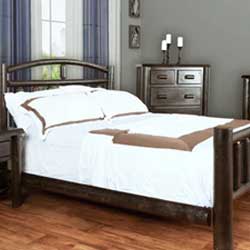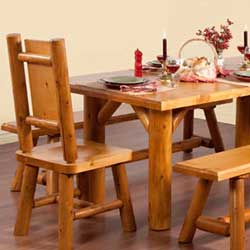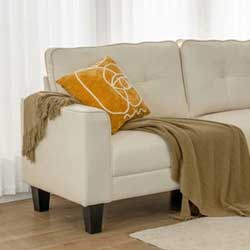Wood Staining and Sealing - Log Furniture and More
Staining wood furniture is a great way to enhance the natural beauty of the wood while also protecting it from damage. Whether it's a new piece of furniture or an old one that needs a refresh, staining can give it a whole new look and extend its life. In this article, we'll take a closer look at the wood staining and sealing process, the benefits of staining and sealing wood, and addressing commonly held safety concerns around wood stains and varnish. Whether you’re in the searching process for new furniture, or looking to bring new life back into existing furniture, we hope this wood stain guide will help you make an informed decision.
What is wood stain?
Wood stain is a pigmented liquid that is applied to wood to change its colour and enhance the natural grain patterns of the wood. Unlike paint, wood stain penetrates into the wood fibres, which allows the grain patterns to show through. The stain can be transparent or opaque, and the amount of pigment used determines the colour intensity of the stain. Wood stain is typically used to change the colour of wood or to bring out the natural beauty of the grain patterns, while also providing some protection against scratches and stains.

What is wood stain made of?
Wood stain is typically made from a combination of pigments, resins, solvents, and oils. The pigments provide the colour, the resins help the stain adhere to the wood, the solvents dissolve the resins and make the stain easier to apply, and the oils nourish the wood and help to protect it from damage. The exact composition of wood stains can vary depending on the manufacturer and the specific type of stain.
Some wood stains are made with natural pigments, such as iron oxides, that are derived from minerals. These natural pigments provide a range of rich colours and are often used in stains for hardwoods such as oak and cherry. Other wood stains are made with synthetic pigments that can provide a wider range of colours and can be more fade-resistant than natural pigments. These synthetic pigments are often used in stains for softwoods such as pine and spruce.
Regardless of the type of pigment used, the resins in wood stains are typically either oil-based or water-based. Oil-based stains are more durable and provide better protection for the wood, but they also take longer to dry and release volatile organic compounds (VOCs) into the air, which can be harmful to both the environment and human health. Water-based stains are more environmentally friendly, dry faster, and do not release VOCs, but they are not as durable as oil-based stains. We will talk about the safety of wood staining later in this article.
Wood varnish vs stain
Unlike wood stain, varnish does not change the colour of the wood, but it can enhance its appearance by brining out natural textures and providing a smooth, glossy finish. Varnish is typically made from a mixture of resin, solvents, and oil, and when applied, it forms a tough and durable surface that protects the wood from scratches, stains, and water damage. Varnished wood is commonly used on furniture, cabinetry, flooring, and other wood surfaces that are exposed to daily use and wear. It is important to note that varnishing is a process that requires skill and patience, as applying it too thickly or unevenly can result in a less-than-desirable result. Seeking a professional to finish wood furniture can ensure an even application so your furniture can stay beautiful and protected for as long as possible.
Wood staining vs painting
Although both staining and painting can add a touch of personalization to wood furniture, they result in vastly different aesthetics that affect the appearance of the wood. Stains are more translucent, preserving and accentuating the individuality of each piece of wood. In contrast, paint is typically more opaque, often obscuring the unique qualities of the wood. Additionally, staining provides greater protection for wood furniture compared to painting. The choice between the two ultimately comes down to personal preference, but it's important to consider the durability and longevity of the furniture when making your decision.

It's not uncommon for both stains and paints to be used in tandem on a piece of furniture. However, it's important to avoid applying them directly on top of each other. Similarly, combining two different stains in the same location is not recommended. Putting wood stain on paint, and vice versa, may prevent the stain from penetrate the surface evenly and can result in an inconsistent and blotchy appearance. Instead, different colouring techniques can be used on different elements of a piece of furniture. For instance, the interior of our Canoe Bookshelves often receives a stain, while the exterior is painted for a pop of colour. When using paint on wood furniture, it's important to add a clear lacquer coat to prevent chipping and protect the finish over time.

Why stain wood?
Protects and Enhances the Wood's Natural Beauty Staining wood not only protects it from the elements and daily wear and tear, but it also brings out the natural beauty of the grain patterns and enhances the overall appearance of the furniture. A wide variety of stains are available, from light and natural to deep and rich, allowing you to choose the perfect shade to complement your decor and personal style.
Easy Maintenance Stained and sealed wood is easy to clean and maintain, simply requiring a damp cloth for wiping down and a light sanding and reapplication of sealer as needed. This makes it a popular choice for high-use areas such as kitchens, bathrooms, and entryways, as well as for furniture that is frequently moved and handled.
Longevity and Durability Staining and sealing wood helps to protect it from daily wear and tear and from damage caused by exposure to moisture and other environmental factors. A well-maintained, stained and sealed piece of furniture can last for many years, becoming a treasured family heirloom or a statement piece in your home.

Do you have to seal stained wood?
Yes, sealing a stained wood surface is important to protect it from damage and to extend its lifespan. Sealing the stain helps to lock in the colour, prevent fading, and protect the wood from moisture, dust, and other environmental factors. A clear polyurethane or lacquer sealer is commonly used to protect stained wood surfaces, and can be applied with a brush or spray.
Can you leave wood unfinished?
Unfinished wood, over time, can lose its natural luster and become dull and discoloured. It is also prone to moisture damage and warping, which can significantly shorten the lifespan and detract from its natural beauty of your furniture. To preserve the wood's appearance and extend its lifespan, it is important to treat it with a finish like a stain or varnish. While some may prefer the raw, natural aesthetic of unfinished wood, but by sealing the wood, you not only preserve its beauty, but also invest in its longevity and durability.
Choosing unfinished furniture has a few disadvantages, such as its tendency to deteriorate quicker and lose its appearance over time due to exposure to moisture, air, dust, etc. Additionally, the natural wood can grey and crack. On the other hand, the main advantage of choosing unfinished furniture is the cost savings, as it is typically less expensive than finished furniture. Ultimately, the decision to finish or leave the furniture unfinished is a personal preference. Some may prefer the look of two-tone furniture or solid-stained wood, while others may appreciate the cost savings of an unfinished piece.

How wood is stained and sealed
Staining wood furniture can seem like a daunting task, but with the right steps, it can be done with ease and result in a stunning, long-lasting finish. Professional staining services use an industrial staining booth machine for consistency and to avoid drip marks. The process for staining and painting furniture can vary, but there are certain steps that are essential for ensuring a high-quality finish.
1. Clean Wood Before Staining
Before beginning the staining process, it is important to properly prepare the wood.This includes cleaning the surface of any dirt, grime, or residue that may interfere with the finish. Use a soft cloth to remove any surface debris, and a wood cleaner or sandpaper to remove any dirt or oils that have accumulated on the surface.
2. Sand Wood Before Staining
Once the wood is clean, it should be sanded to create a smooth surface for the stain to adhere to. Sand the wood with a fine-grit sandpaper, starting with a coarser grit and progressing to a finer grit for a smoother finish.
3. Applying the Stain
When the wood is clean and sanded, it is ready for staining. Use a brush or cloth to apply the stain evenly, following the grain of the wood. Allow the stain to sit for several minutes before wiping off any excess with a clean cloth. Repeat this process if desired, until the desired level of colour is reached.
4. Applying Varnish or Sealer
Once the stain has dried, it is time to apply a protective coat of varnish or sealer. Use a brush or sprayer to apply the varnish evenly, following the grain of the wood. Allow the varnish to dry completely before applying a second or third coat, if desired.

Painting Furniture
For furniture that is to be painted, the process is slightly different. After applying the paint, a clear sealer is added, followed by a tinted sealer and a final sanding. The furniture is then sealed with a lacquer for added durability. If a clear coat is selected, the process is similar, but without the first application of paint. But remember, paint and stains should not overlap as it can cause unfavourable issues.
The Benefits of Professional Staining
While it may be tempting to stain furniture yourself, professional staining services can result in a better, more consistent finish. The use of an industrial staining booth machine and stain gun ensures an even application with no brush lines, resulting in a high-quality finish. Additionally, professional staining can save time and effort, as well as provide peace of mind that the job will be done right.
Wood Stain and Varnish Safety
When it comes to staining and varnishing furniture, safety should be a priority. Not only for the workers handling the chemicals, but also for the end users who will be using and interacting with the finished product. In this section, we will discuss the safety of wood stains and varnish in regards to toxicity and food contact.
Is Varnish Toxic?
Varnish is often made from a mixture of solvents, resins, and oils. Some of these ingredients can release Volatile Organic Compounds (VOCs) into the air. High VOC varnishes can have negative effects on indoor air quality and can be harmful to human health if inhaled in large amounts. It is important to choose low VOC or VOC-free varnishes to reduce the risk of exposure.
Another factor to consider is the durability of low VOC varnishes. Lower VOC products often have lower solids content, making them less durable and less resistant to wear and tear. To balance the trade-off between safety and durability, it's important to choose a varnish with a good balance of low VOCs and high solids content.
Is Wood Finish Safe for Food?
If you are finishing a surface that will come into contact with food, such as a kitchen counter or a dining table, it's important to choose a wood finish that is safe for food contact. Not all finishes are food-safe, and some can release toxic chemicals when exposed to food and drink.
Our conversion varnish is an example of a safe and food-friendly finish option. It is made without any harmful chemicals and does not emit any gasses after 30 days of curing. Additionally, we use water-based finishes that are also safe for food contact. These finishes take about twice as long to sand smooth, but the extra time and effort results in a safer, more food-friendly surface.
Environmentally Sustainable Varnish
We also prioritize environmental sustainability in our finishing process. We recycle our cleaning solvents daily to reduce the evaporation of VOCs and have an engineered spray booth exhaust approved by the Ministry of Environment. By taking these steps, we ensure that our finishing process is not only safe for our workers and customers, but also for the environment.
There are endless ways you can use colour and finishes to personalize your wood furniture. Staining and varnishing enhances the natural wood look and increases durability. Or, you can also choose to paint or leave your wood raw. Your choice depends on your style, goals, budget, and abilities. We hope this article gave you an insight into the benefits and drawbacks of staining and sealing, helping you make a confident decision.


















1 comment